










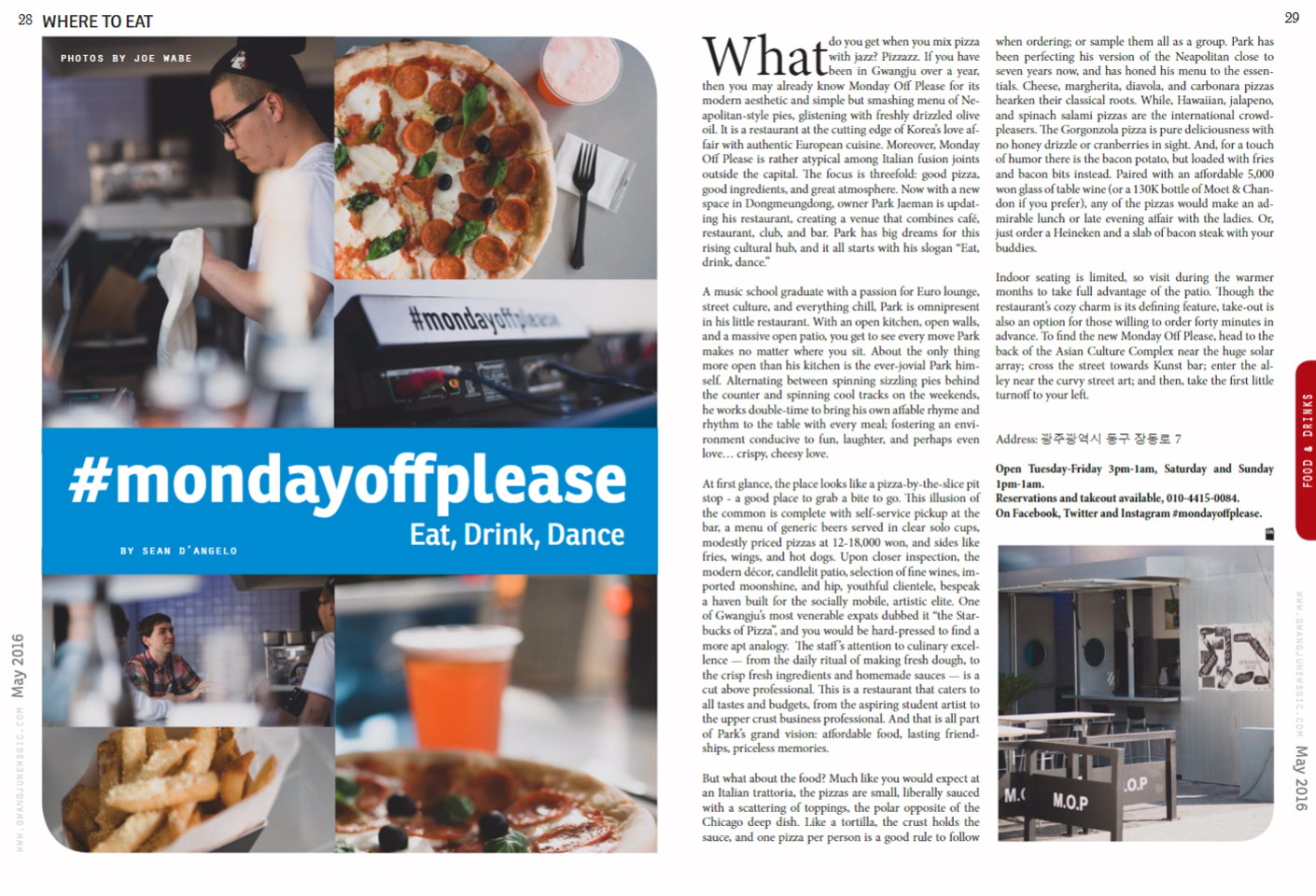
#mondayoffplease
What do you get when you mix pizza with jazz? Pizzazz. If you've been in Gwangju over a year then you may already know Monday Off Please for its modern aesthetic and simple but smashing menu of Neapolitan-style pies, glistening with freshly drizzled olive oil. It's a restaurant riding the cutting edge of Korea’s love affair with authentic European cuisine, and as such it’s rather atypical among Italian fusion joints outside the capital. Here the focus is threefold: Good pizza, good ingredients, and great atmosphere. Now with a new space in Dongmeungdong, owner Park Jaeman is giving his restaurant a facelift, creating a venue that pushes the boundaries between café, restaurant, club, and bar. Park has big dreams for this rising cultural hub, and it all starts with his slogan “Eat, drink, dance.”
A music school graduate with a passion for euro lounge, street culture, and everything chill, Park is omnipresent in his little restaurant. With an open kitchen, open walls, and a massive open patio, you get to see every move Park makes no matter where you sit. About the only thing more open than his kitchen is the ever-jovial Park himself. Alternating between spinning sizzling pies behind the counter and spinning cool tracks on the weekends, he works double-time to bring his own affable rhyme and rhythm to the table with every meal; fostering an environment conducive to fun, laughter, and perhaps even love… Crispy, cheesy love.
At first glance the place looks like a pizza-by-the-slice pit stop, a good place to grab a quick bite to go. This illusion of mundanity is completed by self-service pickup at the bar, a menu of generic beers served in clear solo cups, modestly priced pizzas at 12,000-18,000 won, and sides like fries, wings, and hot dogs. But a closer look at the modern décor, candlelit patio, selection of fine wines, imported moonshine, and hip, youthful clientele, bespeaks a hangout built for the socially mobile, artistic elite. One of Gwangju’s most venerable expats dubbed it “the Starbucks of Pizza,” and you would be hard-pressed to find a better analogy. The staff’s attention to culinary excellence — from the daily ritual of making fresh dough, to the crisp fresh ingredients and homemade sauces — is a cut above professional. This is a restaurant that caters to all tastes and budgets, from the aspiring student artist to the upper crust business professional. And that’s all part of Park’s grand vision: Affordable food, lasting friendships, priceless memories.
But what about the food? Much like you’d expect at an Italian osteria, the pizzas are small, liberally sauced with a scattering of toppings, the polar opposite of the Chicago “deep dish.” This might sound like grounds for complaint, but on the contrary light is the point. Like a tortilla, the crust is there to hold the sauce, not to fill you up, so one pizza per person is a good rule to follow when ordering. Park has been perfecting his version of the Neapolitan pizza for close to 7 years now, and has refined his menu down to a few essentials. Cheese, margherita, diavola, and carbonara pizzas hearken to classical Italian roots. Hawaiian, jalapeno, and spinach salami pizzas are the international crowd-pleasers. The Gorgonzola pizza is pure savory, no honey drizzle or cranberries in sight. And for a touch of humor there’s the bacon potato, which counter to expectation is loaded with fries and bacon bits. Paired with an affordable 5,000 won glass of table wine (or a 130,000 bottle of Moet & Chandon if you prefer), any of the pizzas would make for an admirable lunch or late evening affair with the ladies. Or just order a Heineken and a slab of bacon steak with your buddies if that’s more your style, no one will judge.
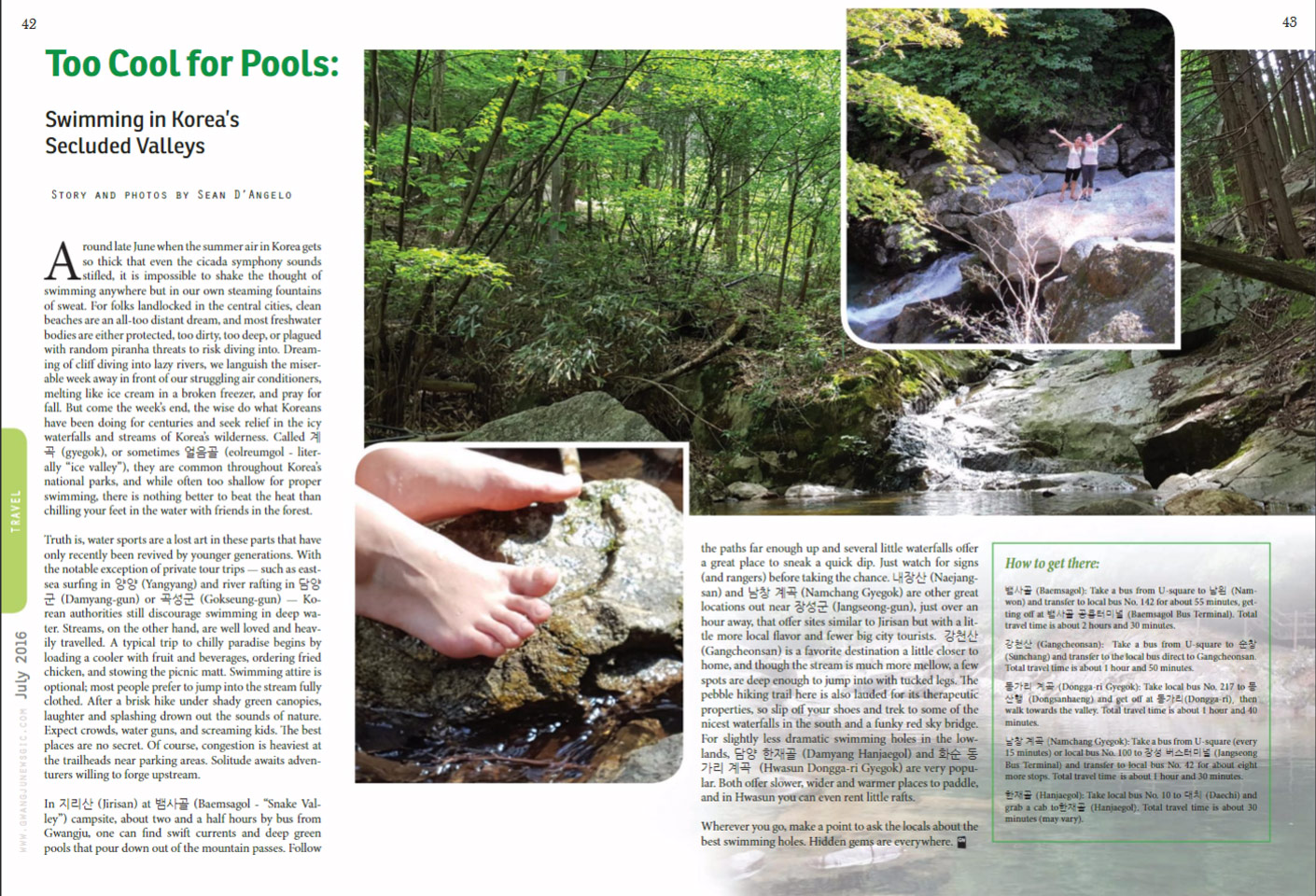
Too Cool for Pools
Swimming in Korea’s Secluded Valleys
Around late June when the summer air in Korea gets so thick even the cicada symphony sounds stifled, it’s impossible to shake the thought of swimming anywhere but in our own steaming fountains of sweat. For folks landlocked in the central cities, clean beaches are an all-too distant dream, and most freshwater bodies are either protected, too dirty, too deep, or plagued with random piranha threats to risk diving into. Dreaming of cliff diving into lazy rivers, we languish the miserable week away in front of our struggling air conditioners, melting like ice cream in a broken freezer, and pray for fall. But come week’s end the wise do what Koreans have been doing for centuries and seek relief in the icy waterfalls and streams of Korea’s wilderness. Called 계곡 (gaegok), or sometimes 얼음골 (aurumgol, literally “ice valley”), they are common throughout Korea’s national parks, and while often too shallow for proper swimming, there is nothing better to beat the heat than chilling your feet with friends in the forest.
Truth is, water sports are a lost art in these parts that have only recently been revived by younger generations. With the notable exception of private tour trips — such as east-sea surfing in 양양 (Yangyang) and river rafting in 단양 (Danyang) or 곡성군 (Gokseung-gun) — Korean authorities still discourage swimming in deep water. Streams, on the other hand, are well loved and heavily travelled. A typical trip to chilly paradise begins by loading a cooler with fruit and beverages, ordering fried chicken, and stowing the picnic matt. Swimming attire is optional; most people prefer to jump into the stream fully clothed. After a brisk hike under shady green canopies, laughter and splashing drown out the sounds of nature. Expect crowds, water guns, and screaming kids. The best places are no secret. Of course, congestion is heaviest at the trailheads near parking. Solitude awaits adventurers willing to forge upstream.
In 지리산 (Jirisan) at 뱀사골 ( Baemsagol, “snake valley”) campsite, about two and a half hours by bus from Gwangju, one can find swift currents and deep green pools that pour down out of the mountain passes. Follow the paths far enough up and several little waterfalls offer a great place to sneak a quick dip. Just watch for signs (and rangers) before taking the chance. 내장산 (Naejangsan) 남창계곡 (Namchang Gaegok) is another great location out near 장성 (Changsong), just over an hour away, that offers sites similar to Jirisan but with a little more local flavor and fewer big city tourists. 강천산 (Gangcheonsan) is a favorite destination a little closer to home, and though the stream is much more mellow, a few spots are deep enough to jump with tucked legs. The pebble hiking trail here is also lauded for it’s therapeutic properties, so slip off your shoes and trek to some of the nicest waterfalls in the south and a funky red sky bridge. For slightly less dramatic swimming holes in the lowlands, 담양 한재골 (Damyang Hanjaegol) and 화순 동가리계곡 (Hwasun Dong Gari Gaegok) are very popular. Both offer slower, wider and warmer places to paddle, and in Hwasun you can even rent little rafts.
Wherever you go, make a point to ask the locals about the best swimming holes. Hidden gems are everywhere.
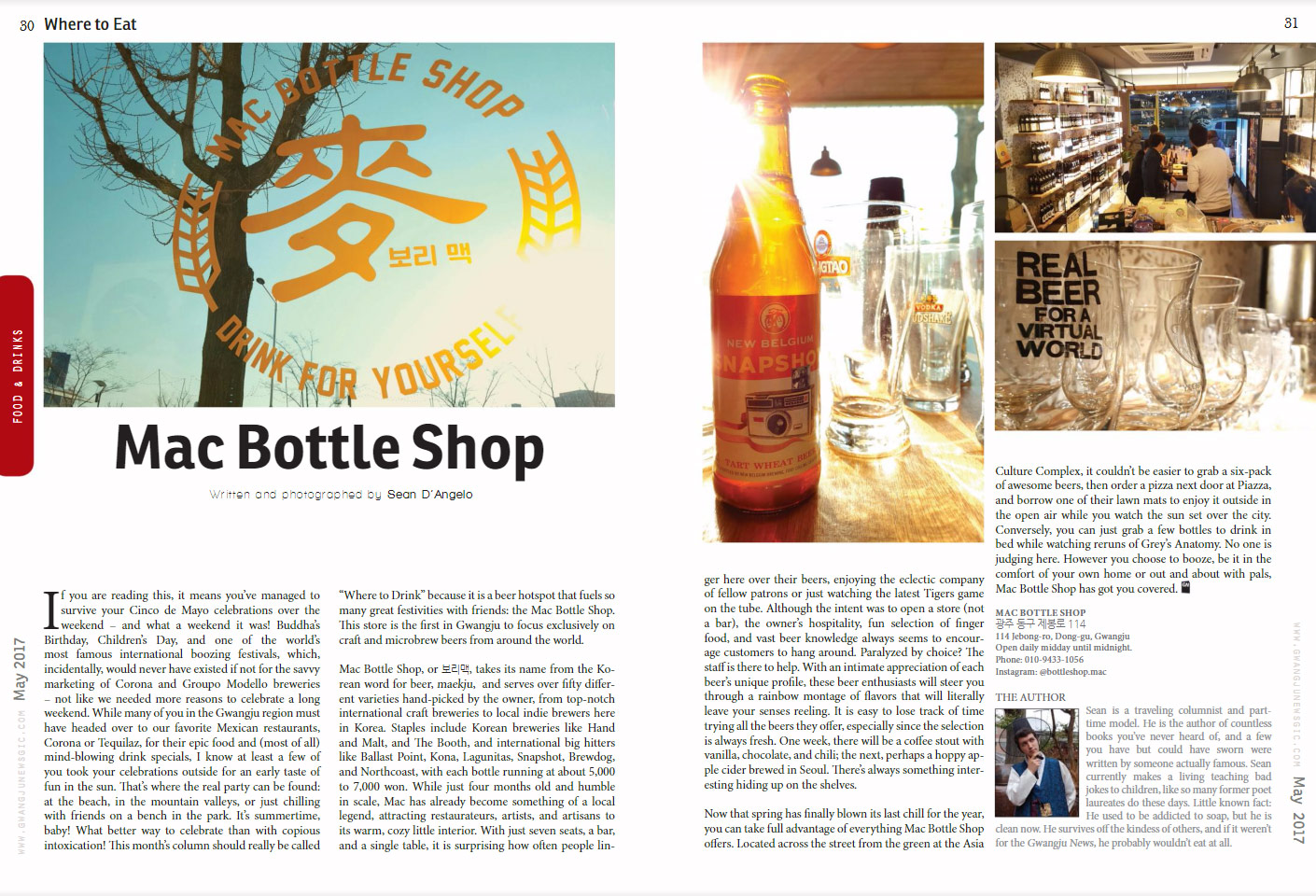
Mac Bottle Shop
If you are reading this it means you’ve managed to survive your Cinco de Mayo celebrations over the weekend, and what a weekend it was. Buddha’s birthday, Children’s Day, and one of the world’s most famous international boozing festivals which, incidentally, would never have existed if not for the savvy marketing of Corona and Groupo Modello breweries. Not like we needed more reasons to celebrate a long weekend. While many of you in the Gwangju region must have headed over to our favorite Mexican restaurants Corona or Tequilaz for their epic food and (most of all) mind-blowing drinks specials, I know at least of few of you took your celebrations outside for an early taste of fun in the sun. That’s where the real party can be found: at the beach, in the mountain valleys, or just chilling with on a bench in the park. It’s summer time baby! What better way to celebrate than copious intoxication! This month’s feature should really be called “Where to Drink” because it is a beer hotspot that fuels so many great festivities with friends. Officially introducing Mac Bottle Shop, the first store in Gwangju to focus exclusively on craft and microbrew beers from around the world.
Mac Bottle Shop, or 보리맥, takes its name from the Korean word for beer “maekju,” and serves over fifty different varieties hand-picked by the owner from top notch international craft breweries to local indie brewers here in Korea. Staples include Korean breweries like Hand and Malt and The Booth, and international big hitters like Ballast Point, Kona, Lagunitas, Snapshot, Brewdog, and Northcoast, with each bottle running at about five to seven thousand won. While just four months old and humble in scale, Mac has already become something of a local legend, attracting restaurateurs artists, and artisans to its warm, cozy little interior. With just seven seats, a bar, and a single table, it is surprising how often people linger here over their beers, enjoying the eclectic company of fellow patrons or just watching the latest Tigers game on the tube. Although the intent was to open a store, not a bar, the owner’s hospitality, fun selection of finger food, and vast beer knowledge always seems to encourage customers to hang around. Paralyzed by choice? The staff has got you covered, with an intimate appreciation of each beer’s unique profile, they will steer you through a rainbow montage of flavors that will literally leave your senses reeling. It is easy to lost track of time trying all the beers they offer, especially since the selection is always fresh; one week there will be a coffee stout with vanilla, chocolate, and chile, the next perhaps a hoppy apple cider brewed in Seoul. There’s always something interesting hiding up on the shelves.
Now that spring has finally blown its last chill for the year you can take full advantage of everything Mac Bottle Shop has to offer. Located across the street from the green at the Asia culture complex, it couldn’t be easier to grab a six pack of awesome beers, then order a pizza next door at Piazza and borrow one of their lawn mats to enjoy it outside in the open air while you watch the sun set over the city. Or you can just grab a few bottles to drink in bed while watching reruns of Grey’s Anatomy. No one is judging here. However you choose to booze, be in in the comfort of your own home or out and about with pals, Mac Bottle Shop has got you covered.
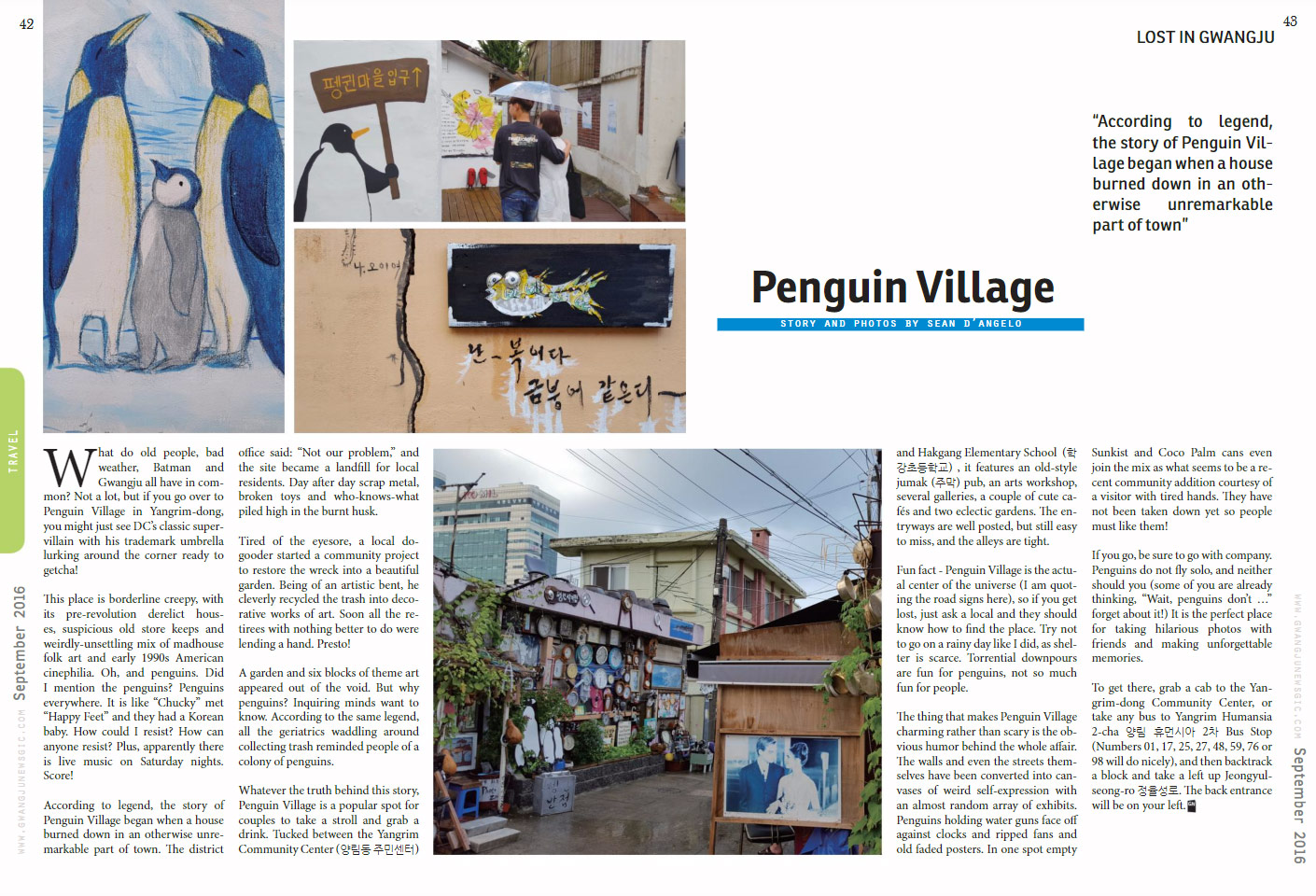
Penguin Village
What do old people, bad weather, Batman, and Gwangju all have in common? Not a lot, but if you go over to Penguin Village in Yangrim dong you might just see Marvel’s classic super villain with his trademark umbrella lurking around the corner ready to getcha! This place is borderline creepy, with it’s pre-revolution derelict houses, suspicious old storekeeps, and weirdly unsettling mix of madhouse folk art and early 90’s American cinephilia. Oh, and penguins. Did I mention the penguins? Penguins everywhere. It’s like “Chucky” met “Happy Feet” and they had a Korean baby. How could I resist? How can anyone resist? Plus, apparently there is live music on Saturday nights. Score!
According to legend, the story of Penguin Village began when a house burned down in an otherwise unremarkable part of town. The district office said “not our problem,” and the site became a landfill for local residents. Day after day scrap metal, broken toys, and who-knows-what piled high in the burnt husk. Tired of the eyesore, a local do-gooder started a community project to restore the wreck into a beautiful garden. Being of an artistic bent, he cleverly recycled the trash into decorative works of art. Soon all the retirees with nothing better to do were lending a hand. Presto! A garden and six blocks of theme art appeared out of the void. But why penguins? Inquiring minds want to know. According to the same legend, all the geriatrics waddling around collecting trash reminded people of a colony of penguins. Oddly irreverent for a formerly Confucian culture, don’t you think?
Whatever the truth behind this story, Penguin Village is a popular spot for couples to take a stroll and grab a drink. Tucked between the Yangrim Community Center (양림 커뮤니티센터) and Hakgang (항각) Elementary school, it features an old style jumak (주막) pub, an arts workshop, several galleries, a couple cute cafés, and two eclectic gardens. The entryways are well posted, but still easy to miss, and the alleys are tight. Fun fact, Penguin Village is the actual center of the universe (I’m quoting the road signs here), so if you get lost just ask a local and they should know how to find the place. Try not to go on a rainy day like I did, shelter is scarce. Torrential downpours are fun for penguins. Not so much fun for people.
The thing that makes Penguin Village charming rather than scary is the obvious humor behind the whole affair. The walls and even the streets themselves have been converted into canvases of weird self-expression with an almost random array of exhibits. Penguins holding water guns face off against clocks and ripped fans and old faded posters. In one spot empty Sunkist and cocopalm cans even join the mix as what I can only assume to be a recent community addition courtesy of a visitor with tired hands. They haven’t been taken down yet so people must like them!
If you go, be sure to go with company. Penguins don’t fly solo, and neither should you (some of you are already thinking ‘wait, penguins don’t…’ forget about it!) It’s the perfect place for taking hilarious photos with friends and making unforgettable memories.
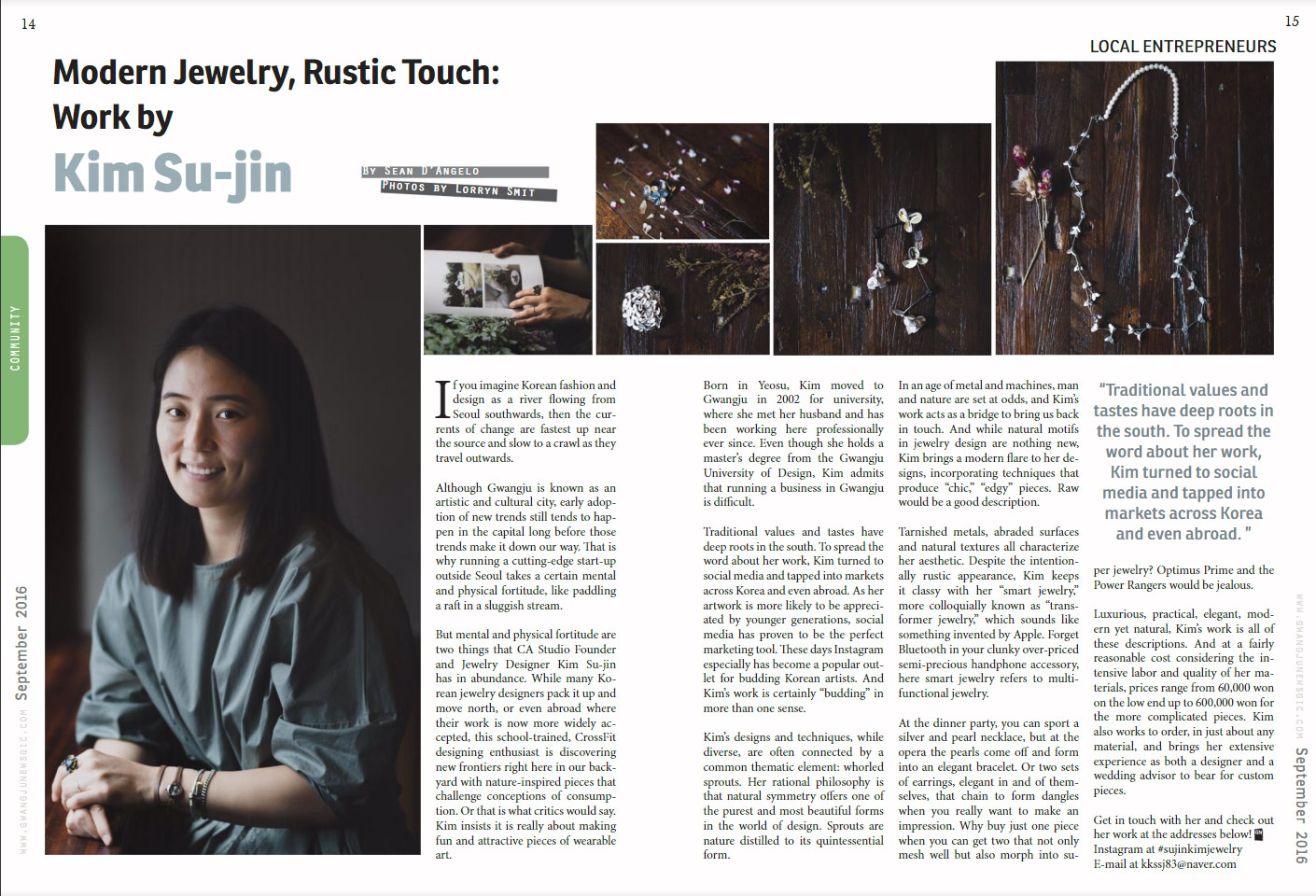
Modern Jewelry, Rustic Touch:
Work by Kim Su-jin
If you imagine Korean fashion and design as a river flowing from Seoul southwards, then the currents of change are fastest up near the source and slow to a crawl as they travel outwards. Although Gwangju is known as an artistic and cultural city, early adoption of new trends still tends to happen in the capital long before those trends make it down our way. That’s why running a cutting edge startup outside Seoul takes a certain mental and physical fortitude, like paddling a raft in a sluggish stream. But mental and physical fortitude are two things that CA Studio founder and jewelry designer Kim Su Jin has in abundance. While many Korean jewelry designers pack it up and move north, or even abroad, where their work is more widely accepted, this design school trained, cross fit enthusiast is discovering new frontiers right here in our back yard with nature inspired pieces that challenge conceptions of consumption. Or that’s what critics would say. Kim insists it’s really about making fun and attractive pieces of wearable art.
Born in Yeosu, Kim moved to Gwangju and in 2002 for university, where she met her husband, and has been working here professionally ever since. Even though she holds a master’s degree from the Gwangju University of Design she admits that running a business in Gwangju is difficult. Traditional values and tastes have deep roots in the south. To spread the word about her work Kim turned to social media and tapped into markets across Korea and even abroad. As her artwork is more likely to be appreciated by younger generations, social media has proven to be the perfect marketing tool. These days Instagram especially has become a popular outlet for budding Korean artists. And Kim’s work is certainly “budding” in more than one sense.
Kim’s designs and techniques, while diverse, are often connected by a common thematic element: whorled sprouts. Her rational philosophy is that natural symmetry offers one of the purest and most beautiful forms in the world of design. Sprouts are nature distilled to its quintessential form. In an age of metal and machines, man and nature are set at odds, and Kim’s work acts as a bridge to bring us back in touch. And while natural motifs in jewelry design are nothing new, Kim brings a modern flare to her designs, incorporating techniques that produce “chic,” “edgy” pieces. Raw would be a good description. Tarnished metals, abraded surfaces, and natural textures all characterize her aesthetic. Despite the intentionally rustic appearance, Kim keeps it classy with her “smart jewelry,” more colloquially known as “transformer jewelry,” which sounds like something invented by Apple. Forget bluetooth in your clunky over-priced semi-precious hand phone accessory, here smart jewelry refers to multifunctional jewelry. At the dinner party you are sporting a silver and pearl necklace, but at the opera the pearls come off and form into an elegant bracelet. Or two sets of earrings, elegant in and of themselves, that chain to form dangles when you really want to make an impression. Why buy just one piece when you can get two that not only mesh well but also morph into super jewelry? Optimus Prime and the Power Rangers would be jealous.
Luxurious, practical, elegant, modern yet natural, Kim’s work is all of these; and at a fairly reasonable cost considering the intensive labor and quality of her materials, with prices ranging from 60,000 on the low end up to 600,000 for the more complicated pieces. Kim also works to order, in just about any material, and brings her extensive experience as both a designer and a wedding advisor to bear for custom pieces. Get in touch with her and check out her work at the addresses below!